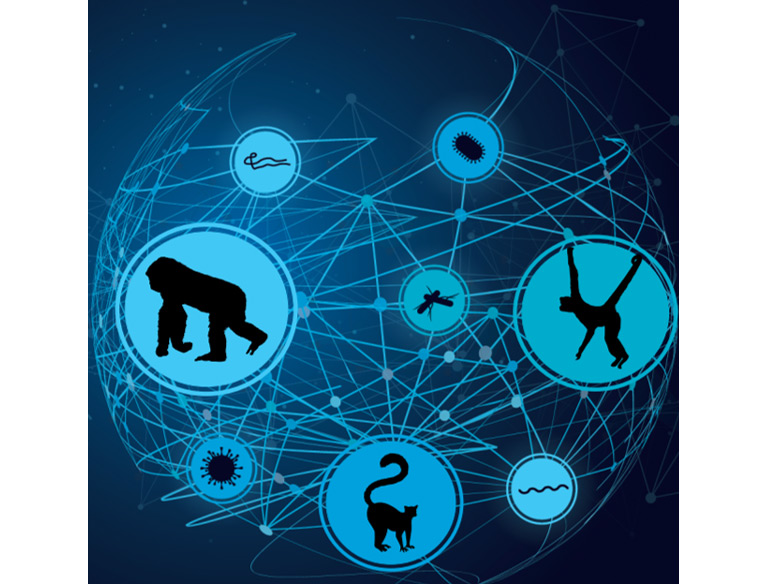Extinction not only threatens primates—their parasites are in danger, too
Dec 1, 2021
- Primates threatened with extinction have highly specific parasites that will likely vanish if their hosts go extinct.
- Parasites play essential roles in ecosystems, but most are so understudied that scientists don’t understand the consequences of losing them.
- If in peril due to a diminishing number of hosts, parasites may try to jump to new host species—potentially triggering unforeseen infections.
Extinction threatens nearly half of all primate species, largely due to human activities. But alongside them, a hidden world of biodiversity also could disappear: parasites.
Using computer modeling, researchers discovered that if all 108 threatened primate species vanish, so could 176 parasite species, according to a recent report in the Philosophical Transactions of the Royal Society B.

Most people would rejoice after such a parasite purge. But these worms, bacteria, fungi, viruses and more actually play vital roles in our ecosystems.
“Animals and parasites have been co-evolving for as long as we both existed,” said primatologist James Herrera of the Duke University Lemur Center in Durham, North Carolina, lead author of the paper.
For instance, the parasitic botfly burrows under the skin of its host—usually howler monkeys, but sometimes people—to lay its eggs. After they hatch, the larvae grow inside huge, bulbous cysts beneath the skin until they burst free. Botflies normally don’t harm animals seriously, but they occasionally kill their hosts or make it harder for them to escape predators—part of the natural control of a population’s numbers.
Most parasites haven’t been studied in detail, so scientists don’t understand the consequences of losing them, said ecologist Rob Dunn of North Carolina State University in Raleigh, who was not involved in the study.
The massive number of threatened primate species make them ideal for examining coextinction: When a host species teeters toward the brink, parasites that rely on it are at grave risk, too. Scientists already see signs of this. Threatened primates carry fewer parasite varieties than healthier groups, hinting that primates in jeopardy have already lost some parasites.

To study primate-parasite coextinction, Herrera and his team constructed a computational network connecting all 213 primate species to the 763 parasites known to infect them. For instance, the scientists linked the parasitic tick Haemaphysalis lemuris to its 10 lemur hosts, including the ring-tailed lemur (Lemur catta) and the black-and-white ruffed lemur (Varecia variegata).
The researchers then removed all 108 primate species designated as Critically Endangered, Endangered, Vulnerable or Near Threatened on the IUCN Red List. In the simulation, 250 parasites lost all known primate hosts. While some of them have other animal hosts to lean on, 176 parasite species are left stranded with no other host options, meaning they would probably disappear if their primates die out.

One such parasite is Moniliformis tarsii. This spiny-headed worm solely relies on the Near Threatened Horsfield’s or western tarsier (Tarsius bancanus)—a tiny brown primate with long, thin fingers and enormous eyes. If this tarsier goes extinct, the worm probably will, too.
“We often imagine extinctions happen in isolation,” Dunn told Mongabay. “As Herrera and colleagues remind us, this is rarely the case.”
Removing a single threatened species did little harm to the interlacing network of primate-parasite interactions in the team’s model. But as more primates disappeared, the web started to collapse.
Even when primates vanish in the wild but live on in zoos, Herrera noted, the captive animals lack most of the unique parasites that had fed solely on that species in the forest.

Parasites in peril may attempt to jump to new host species. Most will fail. But Herrera’s study included more than 100 viruses, highly adaptable parasites that can quickly evolve to infect new hosts. Since primates are our genetic kin, virus spillover could ignite the next pandemic.
This study examined connections between hosts and parasites in a mathematical way. But if we’re not careful, the team concluded, the ripple effects of primate extinction could be just around the corner.
“If we lose these parasites,” Herrera said, “we’re losing whole branches of the evolutionary tree that they represent.”
Citation:
- Herrera, J.P., Moody, J., Nunn, C.L. (2021) Predictions of primate-parasite coextinction. Philos Trans R Soc B. 376(1837) doi: 10.1098/rstb.2020.0355
McKenzie Prillaman (@meprillaman) is a graduate student in the Science Communication Program at the University of California, Santa Cruz. Other Mongabay stories produced by UCSC students can be found here.